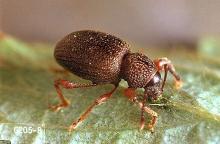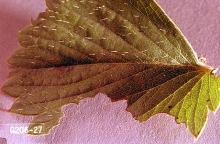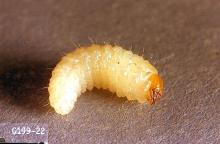Includes
Black vine weevil (Otiorhynchus sulcatus)
Strawberry root weevil (O. ovatus)
Pest description and crop damage Larvae are white with tan heads and have no legs. Adults are black beetles 0.25 to 0.5 inch long. Larvae initially feed on small roots and later on the cambium of large roots. Damage from larval feeding is most apparent just before and during bloom. Weevil presence can be detected by looking for notching or scalloping of the leaves on uprights. Edges of the cranberry bed and drier areas are most susceptible to weevil injury.
Biology and life history Larvae overwinter 2 to 8 inches deep in soil. Most are embedded in the duff. Adults are present in cranberry beds along coastal areas during most of the year but late May to early July is when they can start to be seen in large numbers. They begin egg laying in mid-June to early July. All adults are capable of laying eggs. Eggs normally hatch in 7 to 10 days, but some may overwinter or are deposited in spring by overwintering adults. About 5% of adults overwinter.
Sampling and thresholds Monitor populations of newly emerged adults from late-May to late-June after dark with an insect sweep net. Threshold is one adult per 25 sweeps.
Management-cultural control
Where flooding practices are used during harvest, some weevil larvae often drown. A flood applied for 2 to 3 weeks immediately after harvest, when temperatures may still be warm, can drown large numbers of early-stage larvae.
Management-biological control
- Beauveria bassiana (Mycotrol, BotaniGard, and other brands)-Consult label for rate and use directions. OMRI-listed for organic use.
- parasitic nematodes-See label for rate, timing, soil temperature, and irrigation requirements. Consult Extension personnel or other crop advisers for commercial sources of nematodes.
Management-chemical control: COMMERCIAL USE
- acephate (Orthene 97, Acephate 97UP and other brands)- Consult label for rate PHI 75 in WA or 90 days in OR and ID. Apply at night. To suppress over-wintering adults, apply in early May, before they lay eggs. For newly emerged adults, treat post-bloom when most weevils are in the adult stage and are active but before egg laying begins. Do not apply during bloom; material is hazardous to bees. Do not exceed one application per crop season. Do not tank mix with other organophosphate insecticides.
- azadirachtin (multiple brands)-Consult label for rate. PHI 0 days. Some formulations are OMRI-listed for organic use. Efficacy in the Pacific Northwest is questionable.
- cryolite (Gowan Cryolite Bait)-Consult label for rate. PHI 30 days. Apply late spring to early summer when the majority of adults have emerged and are actively foraging.
- fenpropathrin (Danitol 2.4EC) at 0.3 to 0.4 lb ai/A. PHI 2 days. Do not apply during bloom. Efficacy not tested, but adult control/suppression expected. Restricted use pesticide.
- imidacloprid (multiple available)-See label for actual concentrations. Apply at 0.25 to 0.5 lb ai/A for black vine weevil control. PHI 30 days. Do not exceed 0.5 lb ai/A per crop year. Make first application post-harvest, when plants are dormant (Nov. 1 to Mar. 1). A second application can be made post-bloom the following season. Follow each application with 0.1 to 0.3 inch of irrigation water. Do not apply during bloom or when bees are foraging. Note "Bee Advisory Box" and restrictions on the label. This treatment is only effective in sandy soils.
- indoxacarb (Avaunt, Avaunt EVO) at 0.11 lb ai/A. PHI 30 days. For adult control apply Avaunt at night at the first indication of adult emergence, usually in early- to mid-June. Repeat the applications every 10 to 14 days until adults are no longer obtained by night sweeping. Do not exceed 0.22 lb ai/A for weevil control per year. Material is hazardous to bees.
- thiamethoxam (Actara) at 0.031 to 0.062 lb ai/A. PHI 30 days. Do not apply during bloom. Do not apply pre-bloom if possible. Note "Bee Advisory Box" and restrictions on the label.



